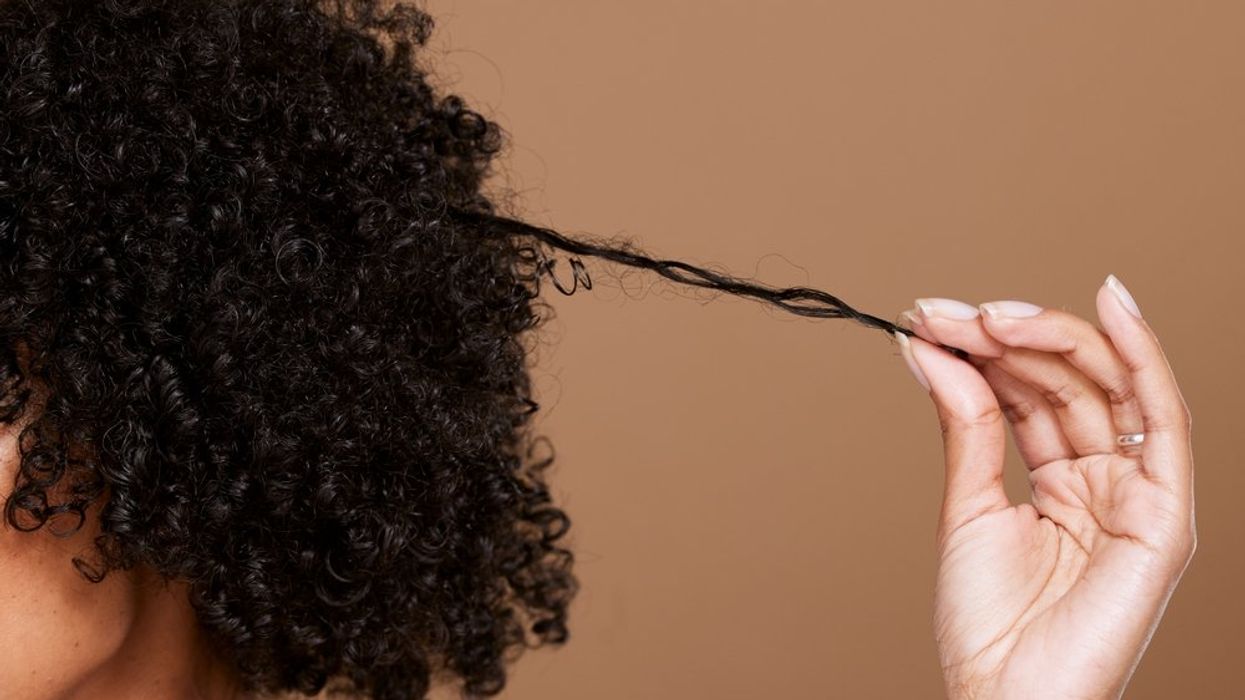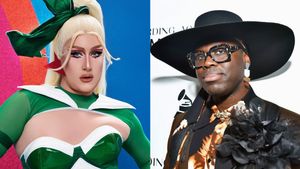Originally published by The 19th. Written by Victoria St. Martin, Inside Climate News
For Jeanette Toomer, the hours she used to spend to ensure that her hair was perfectly done-up years ago was not just a matter of style—it was a cultural statement.
As a Black woman who came of age in the 1970s, Toomer favored natural hair styles over those that required the use of chemicals—a nod to the self-empowerment and return-to-our-roots ethos that rippled across the African-American community in the years after the civil rights movement.
“I started out with plaits and afros when I was in high school,” recalled Toomer, who’s now 66 and lives in New York. “At the time we were trying to be natural, be Black power, all of that. When I was getting ready to graduate, though, I started relaxing my hair.”
Worried that her natural styles would not be taken seriously as she pursued an acting career, Toomer began using chemical straighteners—many of which relied on the toxic substance formaldehyde, a known carcinogen—to straighten and smooth her naturally curly hair.
Now, Toomer fears, the straighteners may have exacted a terrible toll: in 2021—after what Toomer says were more than four decades of regularly using formaldehyde-based relaxers—she was diagnosed with stage 4 endometrial cancer, which she believes can be traced to her use of hair straighteners.
“We were doing these perm relaxers with no idea that we were giving ourselves cancer all these many years,” she said, referring to herself and the untold numbers of other Black women who have used chemical hair treatments since their creation in 1905. “I’m never using it again. I’m never using it again.”
Last month, the Food and Drug Administration proposed a ban on the use of formaldehyde and other formaldehyde releasing chemicals as an ingredient in hair straightening or smoothing products, citing the chemical’s links to cancer and a range of other adverse health effects, including nervous system disorders, respiratory problems and skin conditions.
“Studies have shown that when hair straightening products containing formaldehyde, which are often marketed towards Black women are used with heat, the risk of certain cancers, including certain upper respiratory tract cancers and myeloid leukemias increases,” said Namandjé N. Bumpus, the FDA’s chief scientist, who noted that those health effects are “unacceptable.”
Bumpus, who is Black, said she hopes the proposed ban would help set a standard for “promoting safer alternatives, ensuring that everyone is protected from potentially harmful exposure.”
“This is really an individual decision for people about how they want to present,” said Bumpus in an interview with Inside Climate News, adding that these products disproportionately impact Black women. African Americans make up 14 percent of the population, but spend nine times more on ethnic hair and beauty products than non-Black women, according to a recent Nielsen report.
Bumpus continued: “What’s important to me in my role is to make sure that everyone’s able to do that in a way that is as healthy as can be, and that we’re really protecting people’s health and prioritizing people’s health as they’re making those decisions.”
One study last fall underscored the devastating effects of those exposures: the National Institutes of Health found that there was an increased risk of uterine cancer among women who used formaldehyde-based hair-straightening products at least four times a year. The study said the rates of uterine cancer among Black women have been increasing in the U.S. and that because Black women use hair straighteners more frequently, they may be more affected. Another study by the same team found there was an increased breast cancer risk in connection with the use of hair straighteners as well as permanent hair dye.
The NIH studies are far from the first warnings about the potential hazards of formaldehyde. In 1987, the Environmental Protection Agency found that the substance was a “probable human carcinogen,” and the International Agency for Cancer Research, a division of the World Health Organization, released a similar finding a year later.
With those long-standing scientific studies in mind, researchers and policy advocates welcomed the FDA’s proposed ban. They also say the government needs to ban formaldehyde in all beauty and personal care products—not just chemical straighteners. They also expressed hope that the agency—which will soon be empowered with new authority to oversee cosmetics this December after nearly a century of minimal regulation in the U.S.—should start taking a closer look at other potentially dangerous ingredients.
“It felt like, ‘Finally, about time,” said Ami Zota, a scientist at Columbia University, whose research centers on the adverse health effects of chemicals in beauty products. “Here is the FDA trying to take action—in part motivated both by the science but also the increase in public awareness and the media attention to the issue. The effort feels very piecemeal—but we’ll take it.”

Zota, an associate professor of environmental health sciences, has been documenting how racialized beauty norms compel women of color to disproportionately use cosmetics—and face a greater threat from potentially harmful chemicals than their white counterparts.
The chain of events that led the FDA to begin the process to impose a formaldehyde ban is the story of outdated, 85-year-old guidelines that have largely hamstrung federal agencies when they tried to place controls on the often toxic substances used in cosmetics, leaving government scientists emailing one another with increasing urgency about the need to protect consumers from a known carcinogen. It is also the story of how lobbyists for the beauty industry have successfully forestalled efforts to strictly regulate chemicals; and of women like Toomer, who find themselves questioning whether they placed their health in jeopardy for beauty’s sake.
Toomer compared the relative dearth of information about the harms of chemicals in hair care products to the notorious scientific study at the Tuskegee Institute in Alabama in which Black men with syphilis were not told about their condition—or treatments for it—over the course of 40 years.
“I mean, come on, the fact that they sold it to us and didn’t tell us everything,” Toomer said, referring to formaldehyde-based hair relaxers. “It’s just a history of abusing Black people.”
“The Enormity of the Problem“
As a Black woman in science, this issue hits close to home for Bumpus. She said someone once told her that because of social and professional norms, she would have to change the texture of her naturally curly hair in order to advance.
“I wear my hair naturally, and actually I’ve certainly experienced having people just touch my hair and ask questions about it,” she said “I’ve experienced early on in my career someone saying, if I want to be promoted, then I had to, you know, straighten my hair. So I understand these pressures we have, and I’m very supportive.”
For her, this proposed ban is a “science-based decision.”
Bumpus said: “It’s about what the science and the data are showing us. And that’s what I’m going to, at least from my perspective, always lead with as chief scientist.”
Under the Food, Drug, and Cosmetic Act, a law that has been in place since 1938, the FDA did not have the authority to regulate cosmetic products and their ingredients, other than color additives, before they go on the market. That will change next month, when the Modernization of Cosmetics Regulation Act (MoCRA), passed by Congress late last year, goes into effect. The law represents a significant expansion of the agency’s authority to regulate the beauty industry but does not ban, or require consumer notification of, the most toxic substances used in beauty products, including mercury, formaldehyde, parabens, phthalates and phenylenediamines. The legislation had been under consideration by Congress for at least five years.
Because of the FDA’s lack of oversight, the beauty aisles in stores in America have been lined with products that contain potentially harmful ingredients, including behavioral toxins, carcinogens, developmental toxins, endocrine disruptors, heavy metals, neurotoxins and reproductive toxins.
The regulatory climate in the United States differs significantly from the rest of the world. In Europe, for example, the use of more than 2,400 chemicals in cosmetics has been outlawed. By comparison, in the U.S. 11 chemicals are banned from cosmetics.
“That right there illustrates the enormity of the problem,” said Janet Nudelman, senior director of program and policy at Breast Cancer Prevention Partners, an advocacy organization for cancer patients that has studied links between the disease and toxic substances.
“The cosmetics industry uses over 10,000 industrial chemicals to make the beauty and personal care products that we use every day,” Nudelman said. “And these chemicals are used to grease gears, to sterilize medical equipment, to stabilize plastics, to embalm dead people, yet there’s very little either statutory authority or statutory direction.”
That’s not to say that federal officials haven’t tried to provide that direction.
Having long recognized the dangers of the chemicals, FDA officials have been working for years on plans to ban hair straightening and smoothing products that have formaldehyde and formaldehyde releasing chemicals such as methylene glycol. In 2016, for example, agency scientists were close to finalizing a plan that would have prohibited a hair-smoothing technique commonly known as a “Brazilian Blowout”—a process in which the liquid form of formaldehyde is converted into a gas and released into the air when it is heated by a hair straightening iron.
According to FDA emails obtained by Inside Climate News through a Freedom of Information Act request, agency officials expressed concern that—despite in-depth research on the harms of formaldehyde in the products—a ban did not materialize at the end of the year.
During one exchange in December 2016, Nakissa Sandrieh, the director of the cosmetics division in the FDA’s Office of Cosmetics and Colors, noted that the agency is unlikely to propose a ban. It is unclear from nearly 650 pages of internal emails why the initiative stalled.
“I doubt that anything will now happen, at least in my lifetime,” Sandrieh wrote. “But I am open to good surprises.”
A year earlier, in December 2015, Sandrieh had clearly spelled out the potential dangers of formaldehyde in a statement the office was preparing for a reporter’s inquiry. When a colleague asked why death was listed in the statement as a possible adverse effect of formaldehyde exposure, Sandrieh replied: “The reason we had death included as an outcome, is that if a person is allergic to a cosmetic ingredient, and they have an anaphylactic response, they can die. The cosmetics would have killed them. If a person gets exposed repeatedly to a carcinogen in a cosmetic (formaldehyde), they may get cancer, which may kill them. Again, the death would have resulted from exposure to a chemical in a cosmetic.”
Sandrieh noted, however, there was no way to prove that assertion because agency scientists had few reliable reports that they could use as a guide “and we have no idea what are the levels of ingredients, and how these ingredients react with people’s chemistry, biochemistry, or under conditions of use.”
It’s unclear from the emails—which cover the period from 2013 to 2020—whether agency scientists were able to develop additional evidence to bolster their contention.
The lack of action at the federal level did not prevent individual states from taking matters into their own hands. In 2020, officials in California banned the use of two dozen substances, including formaldehyde, in cosmetics. Oregon and Washington have adopted similar measures. New York and Maine are among the states that are currently considering formaldehyde bans.
In internal FDA emails, scientists did little to hide their frustration at the inertia at the federal level. They also expressed optimism that whatever roadblocks might have existed might one day be lifted.
“We have continued to have impact and influence policy development,” Sandrieh wrote to her colleagues in December 2016. “This will not stop, despite challenges that we face now, and that we will continue to face. We cannot let these bumps in the road slow us down.”
Linda Katz, head of the cosmetics and colors office, replied to that note with a query asking about the status of a safety review of products marketed to African Americans.
Any response that Sandrieh might have offered to Katz was not included with the emails, but an answer may have come earlier this year with the agency’s announcement last month that it was moving forward with its proposed ban.
“We’re focusing on hair straighteners and hair smoothers because of the data and really because of the fact that that heating step has just been shown to be really important as far as formaldehyde release,” said Bumpus of the ban. “You’re heating something that potentially has a lot of formaldehyde in it.”
A spokesman for a pro-industry group, the American Council on Science and Health, said that “given the information we have, it’s not unreasonable that formaldehyde should be taken out of hair straightening products.”
“It’s just terrible stuff,” said Josh Bloom, director of chemical and pharmaceutical research for the organization. “So for the sake of women who are being exposed to unknown quantities of a fairly toxic compound without a really compelling reason, and also for the people who have occupational exposure, it’s not unreasonable to consider a ban.”
“The Wild, Wild West of Regulation“
Those who have pushed for change in regulations around the use of chemicals in beauty products say that the role of lobbyists who work on behalf of the cosmetics industry cannot be underestimated as an impediment to meaningful reform.
In 2021 and 2022, the Personal Care Products Council, the trade group representing the seven companies that make up 90 percent of the American beauty industry, spent more than $2.6 million on lobbying efforts. Since 1998, the Council has spent more than $19 million on lobbying overall.
The effectiveness of their advocacy, public health advocates say, might be most apparent in how little laws governing cosmetics have changed since they were first implemented in 1938. Before the passage of the Modernization of Cosmetics Regulation Act in 2022, the guidelines around the use of chemicals in the production of beauty products had not undergone any meaningful updates, with some exceptions to the ways that colors are regulated—a change that occurred in 1960.
“That is now 60-plus years ago,” noted Melanie Benesh, the vice president for government affairs at the Environmental Working Group, a public health advocacy group. “It was partly a lack of authority—and a lack of an update to authority—and the cosmetics lobby did a very good job of keeping that authority limited. But I think some of it, too, is just even under the best circumstances, it’s hard to get a law passed.”
Under the new law, federal officials can order a mandatory recall if a cosmetic product is deemed unsafe, manufacturers can be compelled to produce a list of the ingredients in what they sell and companies must maintain records of serious adverse health effects that consumers experience in association with their products.
In a statement, the Personal Care Products Council lauded the passage of MoCRA as a “a truly bipartisan effort that brought together a diverse group of stakeholders who gathered in the spirit of collaboration and compromise to advance science-based reforms.”
Nudelman, of Breast Cancer Prevention Partners, said that the Council’s support of the measure may be a result of several key concessions that the industry won as the legislation was being drafted, particularly a provision that prevents states from enacting new laws that require product listing, adverse event reporting or recalls.
“It preempts the states in eight different ways from legislating on cosmetic safety—and this is a real problem,” she said. “The most troubling way is that it blocks the states from enacting laws that would require either cosmetic ingredient reporting or disclosure. And they also can’t force cosmetic companies to substantiate the safety of the ingredients in their products.”
Nudelman continued: “It’s creating a floor, not a ceiling, for cosmetic safety, because there was so little law in place prior to the enactment of MoCRA, where there was only two pages of federal law that existed to regulate a $100 billion cosmetic industry. And now with the passage of MoCRA, there’s 36 pages of new cosmetics safety law. So that’s a lot. But the law didn’t touch the issue of ingredient safety.”
Still, advocates like Benesh said that the additional powers granted to the FDA by MoCRA, which she said won passage thanks to the efforts of lawmakers like Sen. Patty Murray (D., Wash.), represent a significant step forward in protecting consumers.
“We have long said it is sort of been the wild, wild west of regulation of consumer products,” Benesh said. “But we are excited to see the changes in the law and the updates in a lot of the increased oversight from the FDA.”
“The Environmental Injustice of Beauty“
When news broke last month that the FDA was considering a ban on formaldehyde in chemical straighteners, Zota, the Columbia researcher, was giving a talk about beauty justice at a meeting organized by NIH.
“We don’t want formaldehyde and formaldehyde-releasing chemicals in any kind of personal care products,” she said. “But why are we just targeting it in this one type of product and why not target formaldehyde and formaldehyde-releasing chemicals in all personal care products?”
For Zota only “time will tell” if real change comes. Until then, her work continues. She co-authored a review published last month that examined how climate change increases environmental reproductive justice. She and her team examined many studies, including one of her own, that found that people of color are particularly susceptible to the adverse effects of cosmetics because “they use a greater number of products on average, are exposed more frequently to multiple environmental and social risk factors and face poorer health outcomes.”
She and her co-authors wrote that “women of color have higher levels of certain endocrine-disrupting chemicals, such as phthalates and parabens” when compared to their white counterparts.
The disproportionate exposure to chemicals in beauty products is part of what Zota calls the “Environmental Injustice of Beauty”—which is described as “a framework that links intersectional systems of oppression (i.e., racism, sexism) to racialized beauty practices, which in turn, leads to unequal environmental exposures and poor health.”
Zota argues that because of racial discrimination, social beauty norms prioritize the femininity of white women as a standard to which others should aspire. That, Zota said, leads to the use of more toxic products, such as chemical hair straighteners, skin lighteners and fragranced products.
“The continued upholding of Eurocentric beauty standards continues to fuel a demand for the results these products promise, while simultaneously intensifying conditions that make it impossible to permanently achieve, thus driving the use of these products,” Zota and her co-researchers write.
Zota’s team took particular note of the pressure that Black women feel “to maintain their hair using products that contain harmful endocrine-disrupting chemicals, which can impact reproductive health risks.”
That pressure is all-too familiar for Jeanette Toomer.
When she was in ninth grade, Toomer remembers someone asking her about her natural hair, which she sometimes liked to braid. A student asked her: “Oh, look at your hair. Did you do your hair like that?’”
“I said, ‘yeah, it’s done,’” she said. “But you still feel hurt that someone would look at you like ‘you don’t look ready to be here.’”
It was her attempts to secure an acting gig that began decades of perms.
“I was trying to be an actor,” said Toomer, adding that the only role she ever got was to play a prostitute. “My first love was theater and I was going around to auditions, and you had to look a certain way. That’s when I started.”

But years later Toomer heard about the results of the NIH study that found an association between chemical straighteners and cancer. She said if she had known what she knows now, she would have never put them in her hair.
“I was perming it all the time,” said the retired high school teacher who once taught a lesson about beauty standards to her students.
“Natural hair is freedom, said Toomer, who would now advise a young girl facing the same pressures she had years ago to “love yourself and know who you are.”
“God doesn’t make mistakes,” she said. “You are beautiful just the way you are.”
Victoria St. Martin reported this article while participating in the USC Annenberg Center for Health Journalism’s 2023 National Fellowship.
Hair straightener risks

Video Source: Advocate Channel
- It’s Been 25 Years Since a Black Woman Won Album of the Year. Could SZA Change That? ›
- Tori Bowie's Death Is a 'Wake-Up Call' About Black Maternal Mortality, Olympian Allyson Felix Says ›
- 'Ebony Alert' System Enacted in California to Find Missing Black Women and Children ›
- Trevor Noah Thanks Black Women in Last Episode Hosting The Daily Show ›
- Women and people of color bear the brunt of medical misdiagnosis ›


















































